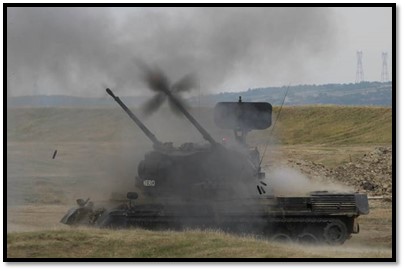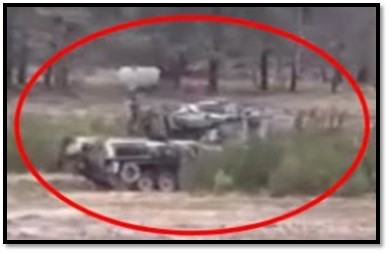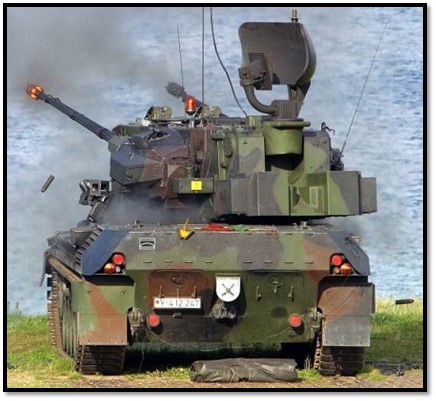By: Warren Gray
Copyright © 2022
“The first…footage of a German-donated, Flakpanzer Gepard
self-propelled, antiaircraft gun in Ukrainian service appeared
online on August 25th. The Gepard, which means ‘Cheetah’…
sports twin, radar-aimed, 35mm automatic cannon that present
a formidable, air defense capability against low-flying, Russian
aerial threats, and can also be used against ground targets.”
— Dan Parsons, for The Drive, August 25, 2022.
The Flugabwehrkanonenpanzer Gepard (“anti-aircraft-gun tank ‘Cheetah’”), better known as the Flakpanzer Gepard, is an all-weather-capable, German-manufactured, self-propelled antiaircraft gun in service since December 1973 but retired from the German Army since late 2010. This very formidable vehicle utilizes the heavily-armored 48-ton hull of a Leopard 1 tank (but is three times more expensive), with a 10-cylinder, supercharged, 819-horsepower diesel engine and an electrically-powered turret mounting twin Oerlikon (Swiss) KDA 35x228mm automatic cannon with 10.4-foot-long barrels, each firing ultra-high-velocity (4,700 feet per second), high-explosive-incendiary (HEI) or frangible, armor-piercing, discarding-sabot (FAPDS) ammuntion at a rate of 550 rounds per minute, or 9.2 rounds per second, with an effective range of 3.4 miles! According to the manufacturer, “The ballistic projectiles cannot be interfered with by electronic defenses, and their fragmentation clouds reliably destroy the target.”
Produced by Krauss-Maffei Wegmann (KMW) of Munich, a total of 377 vehicles were created for the German Army between 1976 and 1980, of which 94 remained in service until 2010 and were replaced by the Wiesel 2 Ozelot light antiaircraft system with four FIM-92H Stinger heat-seeking missiles. Belgium formerly operated 55 Gepards, Chile briefly operated four examples from 2008 to 2011, and the Netherlands had 95 in service until 2006. All of these vehicles were subsequently placed into long-term storage.
Current Gepard operators include Brazil with 36 vehicles, Jordan with 60 former Dutch Gepards, Romania since 2004 with 43 vehicles in its inventory, and most recently Ukraine, acquiring 50 former German Gepard 1A2 models since late July 2022. “It’s exactly what Ukraine needs to defend its airspace,” German Defense Minister Christine Lambrecht candidly told reporters.

Gepard 1A2 system in action. Photo credit: Idaki Karras/Pinterest.
The Flakpanzer Gepard system employs a Siemens/SAG MPDR-12 pulse-Doppler, target-detection/search-only radar mounted at the rear of the swiveling turret with 360-degree search coverage, quickly completing a full scan every second out to a maximum range of 9.5 miles. Mounted on the front of the turret is the smaller Siemens-Albis tracking-only/fire-control radar, or Gepard Tracking Radar, which tracks hostile aircraft in a 200-degree, frontal arc, out to a range of 9.5 miles, with a laser rangefinder to precisely verify target range.
The fearsome twin 35mm cannons are each loaded with 320 rounds of antiaircraft ammunition, and 20 rounds of armor-piercing, anti-tank ammunition for engaging ground targets. When required, it can provide a total firing time of 37 seconds with devastating firepower. The barrels can be elevated from -10 degrees to +85 degrees at a rate of 45 degrees per second. In a normal engagement, 20 to 40 rounds are fired at a single target within one to two seconds.

The Gepard has two large muzzle brakes,
featuring projectile-velocity sensors. Hans-Hermann Bühling, CC BY-SA 3.0, via Wikimedia Commons
Ukrainian Gepard crews wear standard, 2013 pattern, pixelated, woodland camouflage uniforms (or older patterns) and padded leather tanker helmets (or black berets in garrison), and their preferred self-defense weapon in case their vehicles are disabled in action is the small, compact, folding-stock Kalashnikov AKS-74U carbine in 5.45x39mm, or the longer AKS-74 as a readily-available alternative.

Ukrainian soldier with AKS-74U carbine. Photo credit: MilitaryImages.net.
Ironically, the Flakpanzer Gepard system was specifically designed in 1973 to shoot down low-flying Russian aircraft. As David Axe recently wrote for Forbes magazine, “Russian Pilots Have More to Fear As Ukraine’s Gepard Antiaircraft Tanks Arrive: The German and Ukrainian armies also shared a solution to this problem, in the form of a tracked, armored vehicle packing a radar and a pair of 35-millimeter guns with fuzed ammunition that explodes in mid-air.”
“Our capabilities to protect our sky will be strengthened,” Ukrainian defense minister Oleksii Reznikov tweeted. “When the Russian Army widened its war in Ukraine starting in late February, the same old gunships and Su-25s flew overhead. The Ukrainian Army initially lacked adequate air defenses against low- and close-flying aircraft…(So it) went to its Western allies with a list of weapons it needed…A Gepard…is mobile and protected, as it combines the basic chassis of a Leopard tank with a lightly-armored turret.
“Its twin Oerlikon cannons fire 550 rounds per minute out to a range of three miles. The three-person crew is cued by a turret-mounted radar with a nine-mile range. The Gepard is a Su-25 (Frogfoot-A ground-attack fighter)-killer…because Russian doctrine, and the Russian military’s shortage of precision weapons, compels attack pilots to fly very close to enemy forces in order to employ unguided rockets and bombs.”

Gepard 1A2 gun system active in Ukraine on August 25, 2022. Photo credit: Twitter/TheDrive.com.
According to Dan Parsons at The War Zone on August 25, 2022, “German Chancellor Olaf Scholz said that half of the 50 Gepards (including around 6,000 rounds of antiaircraft ammunition) that Germany has promised are already in Ukraine, while the German military is actively training Ukrainian soldiers in their use at a training facility near Putlos in northern Germany.
“The plan briefly ran afoul of Switzerland’s declared neutrality in the conflict, causing that government…to veto a transfer of 35mm ammunition from Germany to Ukraine. Germany was eventually able to find another source for the ammunition, reportedly Norway…they could be highly effective against low-flying helicopters and fixed-wing attack jets, and especially at knocking down drones.
“Russia’s threat of missile strikes on Ukrainian cities reached a new height on August 24. Ukraine’s 31st Independence Day saw 189 air alerts, a host of missile strikes, and the shelling of 58 populated areas where ‘dozens’ of civilians were killed, according to the Ukraine Ministry of Defense…Flying low and fast is a tactic used to evade enemy air defenses, but places the aircraft and crew at much greater risk of striking terrain or obstacles…How little clearance there is between the helicopters and the powerlines, which are a very serious hazard to low-flying rotorcraft and very difficult for pilots to spot.”

A Romanian Gepard 1A2 fires its twin, 35mm cannon during an exercise in 2017. Photo credit: Jen Judson.
Sakshi Tiwari wrote for the Eurasian Times on August 11, 2022, “The Russian Ministry of Defense claimed on August 10 that their troops had destroyed German-supplied, antiaircraft systems of Ukraine…The first three units of the 35mm Gepard self-propelled, antiaircraft weapons arrived in July…Even though it is not verified whether the Russian troops have destroyed the Gepard…Eurasian Times had earlier reported that German artillery and antiaircraft guns were failing in Ukraine due to heavy wear and tear, and…The Gepard…system is incompatible with the Norwegian ammunition.”
Ankit Verma added for Defense View on August 2, 2022 that, “Ukraine has received Norwegian-made, antiaircraft cannon ammunition for use on German Gepards…because Berlin does not have sufficient, 35mm antiaircraft rounds available…The problem is that…the Norwegian, 35mm antiaircraft rounds delivered to Ukraine are not being recognized by the fire-control system software on the Gepard…and therefore the guns could not fire them…(which requires) updating the fire-control system software on these antiaircraft guns…Gepard all-weather-capable, self-propelled, antiaircraft guns are excellent in destroying almost all types of low-altitude, aerial threats on the battlefield.”
However, these ammo compatibility problems were ironed out in late August, and the guns are now fully functional. In fact, tweeted messages later read, “Ukrainian AA (antiaircraft) ‘Flakpanzer Gepard’ shoots down Russian aircraft…Ukraine Gepard laser gun…shoots down Russian helicopter and aircraft…Here we can see some work of the German AA system Gepard against Russian Su-34 (Fullback strike fighter) and attack helicopters Ka-52 (Alligator gunship) … Finally!! Ukraine uses German Gepard antiaircraft tanks to destroy Russian helicopter.”
It’s officially confirmed that since the appearance of the Gepard gun systems in Ukraine in mid-July 2022, the Russian Air Force has lost (by September 25) at least 11 reconnaissance drones, one Ka-52 Alligator helicopter gunship, seven Su-25SM3 Frogfoot-A ground-attack fighters, two Su-30SM Flanker-H highly advanced, multi-role fighter, and three Su-34 Fullback strike fighters in combat action. Based upon Ukrainian Twitter accounts, the highly accurate and ferocious Gepard appears to be responsible for at least several of these drone kills – probably the Ka-52 Alligator, two or more Su-25s, and likely two of the Su-34 Fullbacks, which habitually fly much to low, in order to drop their unguided iron bombs, since precision-guided munitions are in very short supply.
The Gepard manufacturer, KMW, notes that, “The Gepard in air target engagement: The high, off-road mobility and rapid swiveling of the turret enable the extremely short reaction times needed to engage aerial threats. The dual, 35mm automatic cannon can reliably counter anything from attack helicopters and combat aircraft to drones.”

Gepard 1A2 gun system in action. Photo via KMW
The Russian armed forces have thus far (as of October 1, 2022, just three days into autumn) lost at least 262 fixed-wing aircraft (plus up to 224 helicopters and 989 drones), depending upon the sources of information, and as many as 2,312 Russian tanks and 4,889 armored fighting vehicles plus 3,742 other vehicles since their invasion of Ukraine began. Video clips have clearly shown Gepards firing at Russian aircraft, drones, and troop positions. It’s also an absolutely devastating weapon for attacking ground targets, even capable of disabling enemy tanks by blasting apart their electro-optical sighting systems, view ports, radio antennas, and drive sprockets.

Gepard 1A2 camouflaged gun system on the move in Ukraine. Photo credit: Youtube.com.
At least some of those substantial, even staggering, Russian aircraft and ground equipment losses are surely the result of the blazing guns of Ukraine’s mighty cannon-armed Gepards, a devastating air defense weapon system that continues to soldier on nearly a half-century after its inception and long after its retirement from the German Army. But it still wreaks untold havoc on the front lines against low-flying Russian aircraft in a brutal war, “That should make your blood run cold,” as President Biden told the United Nations General Assembly on September 21st.
On that very same day, Russian Defense Minister General Sergei Shoigu openly declared in a televised speech, “At this point, we are really at war with the collective West, with NATO…We’re killing, killing, and killing, and that time has come.” Thus, the huge unanswered question remains: Are the U.S. and NATO really paying attention to this brazen Russian declaration of war against all of NATO, and what are they going to do about it? Sending 50 ex-German Gepard 1A2 gun systems is a fine gesture, but it’s still a band-aid fix for a gaping chest wound in terms of the overall course of the war.
* * *
Warren Gray is a retired, U.S. Air Force intelligence officer with experience in joint special operations and counterterrorism. He served in Europe (including Eastern Europe) and the Middle East, earned Air Force and Navy parachutist wings, four college degrees, and was a distinguished graduate of the Air Force Intelligence Operations Specialist Course, and the USAF Combat Targeting School. He is currently a published author, historian, and hunter. You may visit his website at: warrengray54.vistaprintdigital.com.

